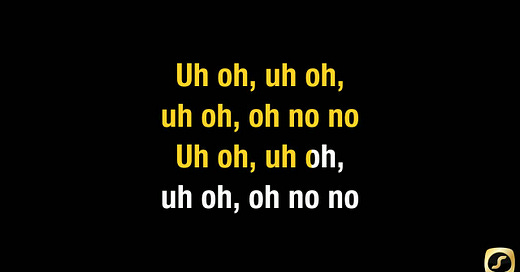Summer hasn’t technically started, but we are weeks into “song of the summer” season. People and platforms guess which single will anthemize the months ahead; in September, they’ll reconvene for the final call. This is both a social pastime and a content boon for media outlets, which use different metrics to make the determination: Billboard has published a “Songs of the Summer” chart since 2010; MTV holds a fan vote; Variety goes mostly by streaming numbers.
It’s impossible to date the concept, or the practice, precisely, though Phil Edwards at Vox tracked down a New York Tribune article from 1910 asking what that year’s song of summer would be, noting that 1909’s was a tune called “My Wife’s Gone to the Country! Hooray! Hooray!” (Other contenders were “McGinty,” “Elsie from Chelsea,” and “Where Did You Get That Hat.”) As Chris Molanphy wrote in Slate, the idea was ambient throughout the 20th century, but became a media staple in the mid-1990s. A New York Times Magazine feature from 1995 discussed “the No. 1 Summer Song of Love,” which, that year, was “I’ll Be There for You/You’re All I Need to Get By” by Method Man and Mary J. Blige.
The song of summer “is fundamentally a socialist kind of thing,” Mim Udovitch wrote that same year. “We all get an equal share, regardless of our class or station in life or even our own volition.” Some believe “there can only be one,” and I’m sympathetic to that argument, though it doesn’t always work in practice. Occasionally, you get a summer hit so massive that nobody would contest it (“Despacito,” 2017), but sometimes you get multiple hits, of varying satisfaction (“One Dance,” “Cheap Thrills,” “Can’t Stop the Feeling!,” 2016), and other times plain disagreement (2015’s song of the summer was definitely “Trap Queen,” to my mind, but Billboard named it “Cheerleader.”)
The song that tops the charts one summer is not necessarily the one you hear blaring from cars and in parks and at block parties. There’s the country’s statistical song of summer; then there’s the song of summer for your city, your neighborhood, your friend group. Besides: I think that determining the song of summer is less an investigation than a ritual.
This ritual has at least two important functions. One of them is indexical. A summer’s song is its icon ever after. As Stephan Talty wrote in that Times Magazine piece, the summer love song’s “true role is to carry the moment into the future, not as history, but as a madeleine of pleasure and heartbreak.” These madeleines are historical. Inevitably they say something about the culture in which they hit, and about one’s vantage point within it.
The second function is anticipatory. Because just as we need vessels for our nostalgia, we need ones for our hopes. There’s the empirical song of summer, determined after the fact, and then there’s the hypothetical song of summer, in which we invest our summer longings. To set a theme, and to exorcize those specific discontents that have built up over the colder months. But also to bottle a general feeling of warmth toward the future, something that swarms in late spring, and something most people don’t get to feel very often. Less and less in the sweltering-hot months of midsummer, or the eerily hot months of fall.
I say “warmth toward the future,” as opposed to “optimism,” because I think these are two different things. Optimism is an attitude; something that people tend to choose, regardless of how they feel. You could call it an ideology, or a political practice. Of course, one might “feel optimistic”—as in, have a hunch that things will work out—but what I’m referring to is a general sense of possibility. The outcome might be good, or more complicated than good; what’s important is that it be worthwhile. This is not necessarily an easy feeling. More a restlessness you allow yourself.
In a way, the song of summer holds a longing that holds a longing. The desire for something to look forward to—for life, for renewal—tends to coalesce in a person. It often ignites a longing for romance, or vice versa (though not always romantic longing; the prospect of a new friend can hold the same anticipatory charge). For me, late spring is crush season. I become particularly susceptible.
When I was younger, to crush on someone was to want them. If we got together, I thought, the longing would be satisfied; the future would arrive. We all know the longing is never satisfied. It’s seasonal. I thought this restlessness would diminish with age, or find a new main repository, but it hasn’t exactly. Sometimes that makes me anxious, in predictable ways. But if desire is here to stay, I have to keep negotiating my relationship to desire—to hold it lightly, to let it be.
Crushes, like summer hits, are both specific and not. There’s something about this person; they just do it for you. But something has also attached to them—a general lust for connection, which is what the “song of summer” is really about, beyond the hype cycle, beyond the content opportunity. You might hate the Billboard number one this year, but there is going to be a song you’ll want to sing with strangers at the bar, or dance to on the lawn of a public park, one that promises nothing but holds every possibility, and the restless need for others.





https://youtu.be/GXT71d5Id0o will forever by my summer crush song. Every week for nearly a year at the same club I saw her we always made eye contact and smiled when this song came on, we never spoke. I will always ‘love her like crazy’ 🌅
https://youtu.be/M2HpOvW-C1w This is tapping into some other younger more free summer that giving jouissance ❤️